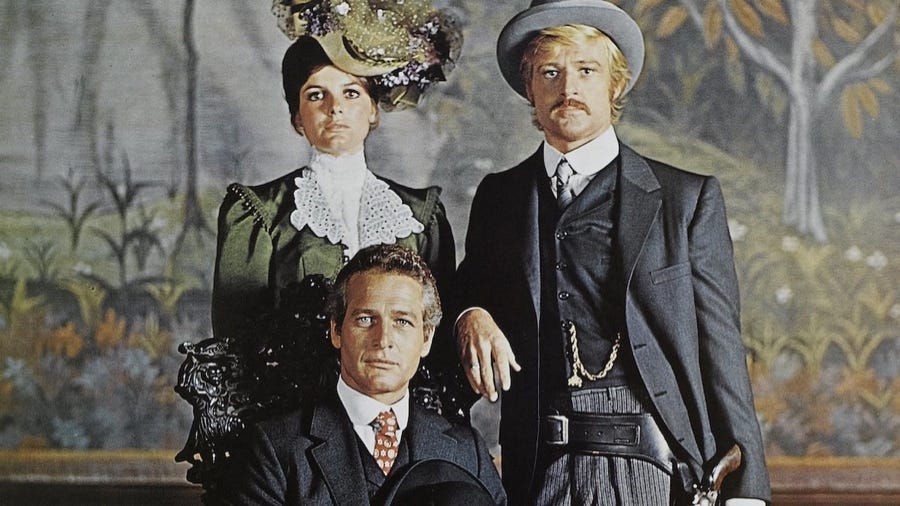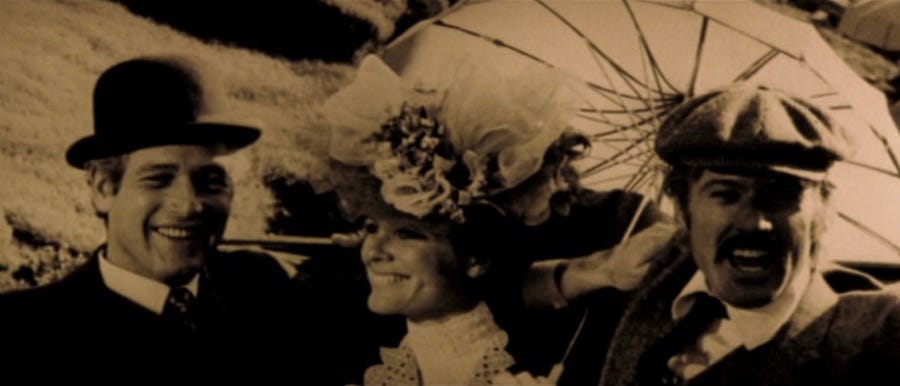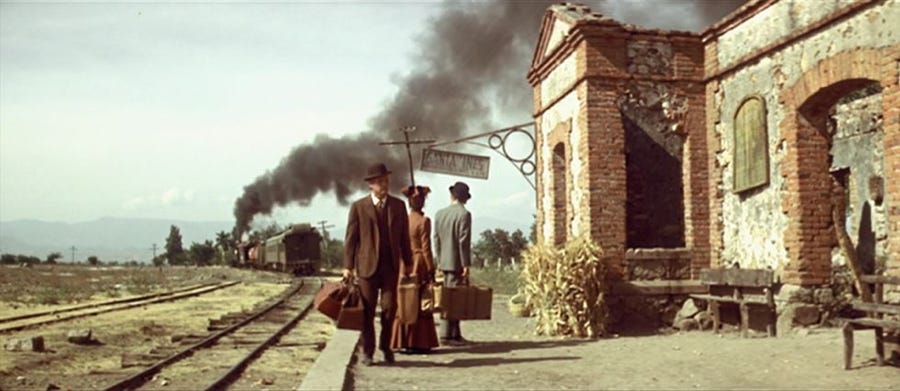Butch Cassidy and the Sundance Kid (1969)
"Boy, I got vision, and the rest of the world wears bifocals..."
“I never met a soul more affable than you, Butch, or faster than the Kid, but you're still nothing but two-bit outlaws on the dodge. It's over, don't you get that? Your times is over and you're gonna die bloody, and all you can do is choose where.”
The Wild West is over. Dead. Kaput. Finis. Growing up in the 70s, even in the English Home Counties, was to reenact Custer’s Last Stand in the playground. The Romance of the Old West. We played at ‘Cowboys and Indians’ — as it was then called — with toy Colt Peacemaker, bow and arrow and feathered headdress. I built a wigwam in my grandparents’ garden. On hot, summer Saturday afternoons there was The High Chaparral (1967) and Alias Smith and Jones (1971): a world of gunslingers, Indian Braves, Mexican Banditos, saloons, hard liquor, rattlesnakes and hairy cactus. In America, every boy worth his salt owned a Daisy Red Ryder BB gun, a Winchester Repeater in miniature. The imagery of the Old West was everywhere and anywhere.
Yet, by the early 1970s, and partly thanks to the Vietnam War, the ‘Western’ had fallen out of fashion. The love affair with a romantic and reimagined ‘Wild’ West is a concept of the 20th century, that, curiously, began only a few years after the real Old West had finished. The ‘Western’ stood for the pioneer spirit, in accord with the conservative 50s and the macho early 1960s — as Rich Hall says in How The West Was Lost (BBC4): in 1953 a third of all studio pictures released was a Western. High Noon (1952), Shane (1953), Last Train from Gun Hill (1959), How the West was Won (1962) — the names trip off the tongue. And in a sense, even Star Trek (1966) (to split infinitives like no man has split infinitives before) is a Western, the Starship Enterprise a covered waggon lumbering across spectacular plains i.e. space; Captain Kirk (William Shatner) a hunk of All-American pioneering manhood, albeit Canadian manhood. These days, as a cultural concept, the Old West — and all that it stands for — is (how can I put this politely?) considered ‘not exactly PC’, and the classic Western (once the staple of afternoon television) rarely gets an outing. The cap guns, the bow and arrow and the plastic Sheriff’s badge consigned to a dusty, forgotten nursery cupboard. And the historical reality has its darker side: the enforced Indian reservations, the massacre at Wounded Knee, and the slaughter of the unfortunate North American bison — gunned down en masse from the railroad coach, skins removed, and bones ground up for fertiliser, an event which brought that magnificent creature to near extinction. For by 1890, it was estimated that only 500 bison survived. At the same time, the demise of the cinematic Western mirrored the end of the original Old West, which, by 1900, had become decidedly Old Hat. For as early as the summer of 1885, Chief Sitting Bull, the leader of the Lakota resistance, had become a star attraction in Buffalo Bill Cody’s Wild West Show — a humiliating experience, surely, for a great warrior and mystic, believed to have the gift of prophecy.
The real Butch Cassidy (Robert LeRoy Parker) was born in Utah Territory in 1886, and by 1896, had recruited Harry Alonzo Loughborough, the ‘Sundance Kid’, into the Wild Bunch, his gang of criminal desperados. The mysterious and enigmatic Etta Place is thought to have been the Kid’s girlfriend. Very little is known about her. Both her origin and her fate remain unknown. In Bruce Chatwin’s In Patagonia (1977), Chatwin discovers a log cabin built by Butch Cassidy. Bruce Chatwin, now unfashionable, remains one of my favourite writers:
In the fall of 1901 Butch met the Sundance Kid and his girl, Etta Place, in New York. She was young, beautiful and intelligent, and she kept her men to heel. Her Pinkerton card says she was a school teacher in Denver; one rumour has it she was the daughter of an English remittance man called George Capel, hence Place. Under the names of James Ryan and Mr and Mrs Harry A. Place, the ‘family of 3’ went to operas and theatres. (The Sundance Kid was a keen Wagnerian.) They bought Etta a gold watch at Tiffany’s and sailed for Buenos Aires on SS Soldier Prince. On landing they stayed at the Hotel Europa, called on the Director of the Land Department, and secured 12,000 acres of rough camp in Chubut.
And that, I think, is what Butch Cassidy and the Sundance Kid (1969) is all about. A last gasp, a tribute, the end of an era, an affectionate farewell. Even if subsequent westerns checked the decline, to some extent — Robert Altman’s McCabe and Mrs Miller (1971), Clint Eastwood’s High Plains Drifter (1972) and Unforgiven (1992). But director, George Roy Hill, wasn’t to know that. There’s a splendid, wise little speech in the bit where Butch (Paul Newman) and Sundance (Robert Redford) tie up Sheriff Bledsoe (Jeff Corey): “It’s over, don’t you get that? Your times is over and you’re gonna die bloody, and all you can do is choose where…” Which explains why Butch, Sundance and Sundance’s girlfriend, Etta Place (Katherine Ross) depart for sunny Bolivia.
Today, Butch Cassidy is a much-loved classic, in Britain, a film despite the demise of the Western, still broadcast on rainy Bank Holiday Mondays (I think?), a film which holds an immense nostalgia for many of us, although readers may be surprised to learn that distinguished critics slated the film on release. Despite its significant box office success (it was the top grossing film for 1969). Roger Ebert gave it a meagre two and a half stars, describing William Goldman’s script as ‘constantly too cute and never gets up the nerve, by God, to admit it’s a Western’, and criticising director George Roy Hill for the seemingly never-ending posse chase (which to be fair, is similar to the never-ending posse chase in Heaven’s Gate [1980]), and the modern, anachronistic dialogue, ‘for the benefit of us clever 1969 types’, and ‘the violent, bloody ending… apparently a misguided attempt to copy Bonnie and Clyde.’
Burt Bacharach’s music came in for reproval too: too contemporary, too sugary. Too slick by half. Especially during the lyrical bicycle scene with Paul Newman and Katharine Ross — yet another example of the late 60s and early 70s Victorian/Edwardian revival à la Laura Ashley. This sequence is, of course, set to the Burt Bacharach classic, Raindrops Keep Fallin’ on My Head, sung by B. J. Thomas, and for which Burt won a deserved Oscar, yet which, by the 1980s, had been demoted to the status of supermarket lift music or naff cruise ship singers; a masterclass in lens flare, backlighting and soft focus — like a glossy television commercial for Pepsi, Martini or Cadbury’s Flake. These days, of course, with the passing of time, what seemed contemporary (and subsequently anachronistic) then, now seems decidedly retro. There’s also a rather lovely sequence in the middle of the film, with the trio living it up in fin-de-siècle New York, just before they set off for Bolivia, an atmospheric montage of still photographs in sepia, very much of its time, set to Bacharach’s wistful, nostalgic — and rather beautiful — Not Goin’ Home Anymore (especially when played on a honky-tonk piano), with slow panning and zoom, now described as the ‘Ken Burns effect’: and if you’ve seen Burns’ superb Civil War television documentary from 1990, you will know immediately what I’m talking about.
Butch Cassidy and the Sundance Kid (1969) is one of my favourite films. A nostalgic reinterpretation, as seen from the point of view of the late 1960s. Which makes it interesting. And Burt Bacharach’s music is, of course, a triumph. Especially the catchy jazz scat of South American Getaway — ba, ba, bar, bar, ba, bar, barrrr… which, again, came in for stick at the time. That’s the bit with the horses and the hapless Bolivian police. And yet, Butch Cassidy and the Sundance Kid is a great example of a film, I think, which relies on its soundtrack. Bacharach, surely, was a genius: a Cole Porter for the mid-to-late 20th century. And Paul Newman, Robert Redford and Katharine Ross (later to star in Bryan Forbes’ The Stepford Wives (1975) are class acts too — you don’t need me to tell you that. Newman and Redford reprised similar, buddy-buddy roles in George Roy Hill’s The Sting (1973), the fabulous gangster film (terrific production design!) which we will most definitely return to at a later date — and another one to add to the list. Incidentally, She Who Can Do No Wrong Jacqueline Bisset was, apparently, top of the casting list for the role of Etta Place: as much as I like Katharine Ross, one of the great ‘ifs’ of 1960s cinema.
And the inevitable ending, which again, upset the critics, and perhaps, might today seem a little bit clichéd (certainly by Peter Weir’s Gallipoli [1981]), is, I think, highly effective. With that single, freeze-frame moment, dissolving into sepia, two outlaws pass into legend. The Myth of the Old West. But here’s Bruce Chatwin on what may, actually have really happened. In real life:
The classic account of their death, at San Vincente, Bolivia, in December 1909, following their theft of a mine payroll, was first set down in Elk’s Magazine for 1930 by the Western poet, Arthur Chapman. It was an ideal scenario for the moviemakers; the brave cavalry captain shot while trying to arrest the gringos; the mud-walled courtyard full of dead mules; the impossible odds; the Kid first wounded, then shot through the head by Butch, who, having now killed a man, reserves the last bullet for himself. The episode ends with the Bolivian soldiers finding Etta’s Tiffany watch on one of the bodies.
I watched Butch Cassidy and the Sundance Kid (1969) on DVD. My edition includes an illuminating documentary, The Making of Butch Cassidy and the Sundance Kid (1970), which slightly surprisingly for an American documentary made in 1970, includes salty language: the four letter word is usually thought to have entered the mainstream in Robert Altman’s M*A*SH*, released in the same year. There’s also a Blu-ray, in which the film is classified as a ‘comedy western’. I’m not sure I would describe it as such, altho’ I gather Paul Newman wrestled with the supposed ‘comedy’ aspects during his performance. It’s all a little bit ambiguous. Both the film and the documentary are available to download on Amazon Prime Video, with the film at a bargain £4.99 (to buy) and the documentary £2.49 (to rent). And there’s Netflix. Burt Bacharach’s magnificent soundtrack is available on Spotify, where there’s also an especially good cover of South American Getaway by jazz singer Anne Walsh, plus a further rendition from the jazz group, Jazz At The Movies, which can be found in their album, Kiss Kiss Bang Bang. Both come with my recommendation.
Okay. Time for a recap. It’s hard to believe but this is film recommendation No. 117. And you’ve just been reading the Sunday morning post for both ‘paid for’ and free subscribers. Join le gratin, become a ‘paid’ subscriber and you’ll get an extra, exclusive post on Friday mornings, plus further ‘bonus’ posts on High Days and Holy Days. Worth thinking about. I hope you enjoy Butch Cassidy and the Sundance Kid (1969) as much as I did. It’s the perfect antidote for a goomy Sunday afternoon or a depressing Sunday Evening. Bourbon whisk(e)y for this one. I’ll be back on Friday…












Triggers lovely soft focus memories, Luke.
If you ever find yourself near Telluride, Colorado visit Dunton Hot Springs a former gold mining camp, pull up a stool and enjoy a drink at the Saloon where Butch and the Kid carved their names into the wooden bar top
Time to make some popcorn and introduce my 10 year old to this film.
He watched Annie Hall with me on Friday and loved it.